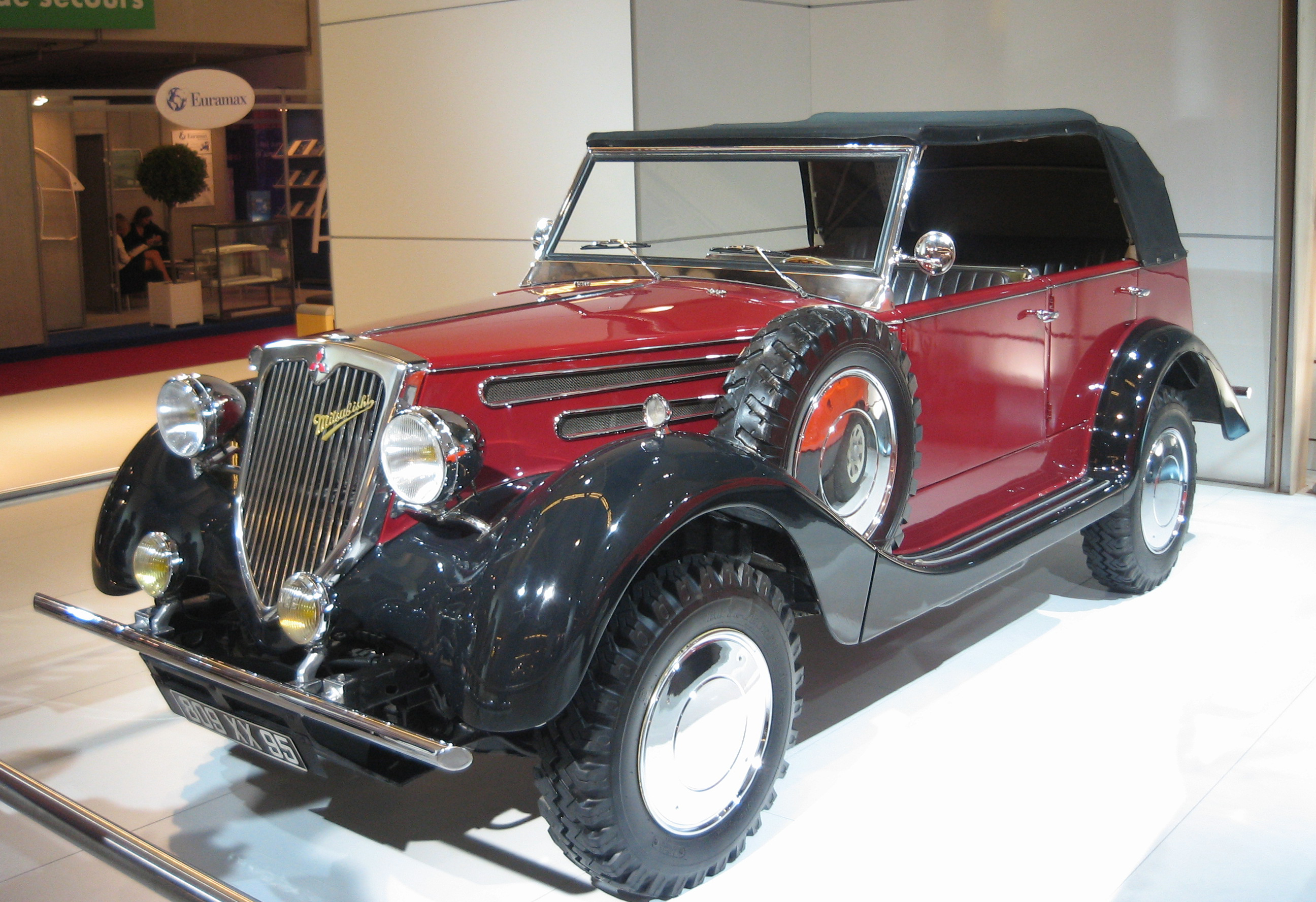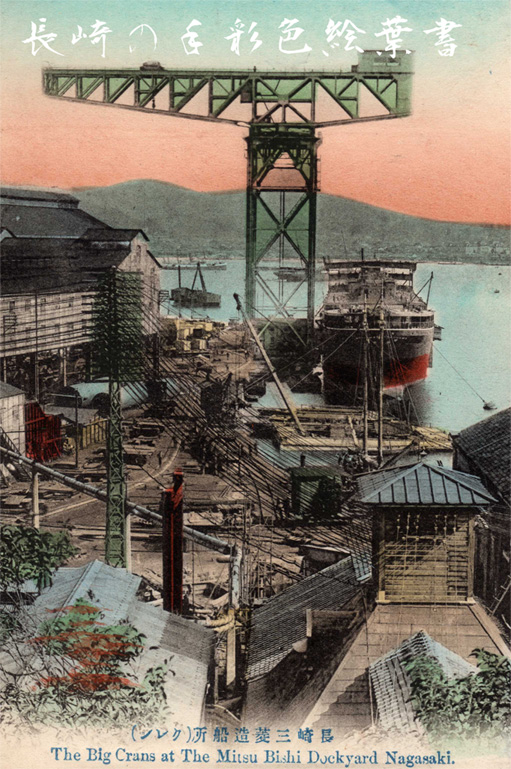|
Mitsubishi 500
The Mitsubishi 500 was the first passenger car produced after the Second World War by Shin Mitsubishi Heavy-Industries, Ltd, one of the companies which would become Mitsubishi Motors. It was built from 1960 until 1962 and formed the basis for Mitsubishi's next model, the Colt 600. It was exported in small numbers. History First shown at the 1959 Tokyo Motor Show, it became available in 1960 at a cost of ¥390,000. It was powered by a rear mounted, air-cooled 493 cc two-cylinder engine with a single downdraught carburettor producing at 5,000 rpm, driving the rear wheels through a three-speed manual transmission. The body was a monocoque, in order to be light and strong enough to reach the goal of seating four and reaching 100 km/h with such a small engine. Chassis code was A10, later A11. 500 Super DeLuxe Buoyed by its sales success, it was given an enlarged 594 cc engine (NE35A) in August 1961 for improved acceleration and durability. This model was known ... [...More Info...] [...Related Items...] OR: [Wikipedia] [Google] [Baidu] |
Mitsubishi Motors
is a Japanese multinational automobile manufacturer headquartered in Minato, Tokyo, Japan.Corporate Profile , Mitsubishi Motors website, 19 June 2008 In 2011, Mitsubishi Motors was the sixth-largest Japanese automaker and the 19th-largest worldwide by production. Since October 2016, Mitsubishi has been one-third (34%) owned by Nissan, thus a part of the . Besides being part of the Renault–Nissan–Mitsub ... [...More Info...] [...Related Items...] OR: [Wikipedia] [Google] [Baidu] |
Mitsubishi Heavy Industries
is a Japanese multinational engineering, electrical equipment and electronics corporation headquartered in Tokyo, Japan. MHI is one of the core companies of the Mitsubishi Group and its automobile division is the predecessor of Mitsubishi Motors. MHI's products include aerospace and automotive components, air conditioners, elevators, forklift trucks, hydraulic equipment, printing machines, missiles, tanks, power systems, ships, aircraft, railway systems, and space launch vehicles. Through its defense-related activities, it is the world's 23rd-largest defense contractor measured by 2011 defense revenues and the largest based in Japan. History In 1857, at the request of the Tokugawa Shogunate, a group of Dutch engineers were invited, including Dutch naval engineer Hendrik Hardes, and began work on the ''Nagasaki Yotetsusho'' 長崎鎔鉄所 , a modern, Western-style foundry and shipyard near the Dutch settlement of Dejima, at Nagasaki. This was renamed ''Nagasaki Seit ... [...More Info...] [...Related Items...] OR: [Wikipedia] [Google] [Baidu] |
Straight-twin
A straight-twin engine, also known as an inline-twin, vertical-twin, or parallel-twin, is a two-cylinder piston engine whose cylinders are arranged in a line along a common crankshaft. Straight-twin engines are primarily used in motorcycles; other uses include automobiles, marine vessels, snowmobiles, Jet Skis, all-terrain vehicles, tractors and ultralight aircraft. Various different crankshaft configurations have been used for straight-twin engines, with the most common being 360 degrees, 180 degrees and 270 degrees. Terminology The straight-twin layout is also referred to as "parallel-twin", "vertical-twin" and "inline-twin". Some of these terms originally had specific meanings relating to the crankshaft angle or engine orientation, however they are often also used interchangeably. In the United Kingdom, the term "parallel-twin" is traditionally used for engines with a crankshaft angle of 360 degrees, since the two pistons are in the same direction (i.e. parallel to each ... [...More Info...] [...Related Items...] OR: [Wikipedia] [Google] [Baidu] |
Rear-engined Vehicles
In automobile design, a rear-engine design layout places the engine at the rear of the vehicle. The center of gravity of the engine itself is behind the rear axle. This is not to be confused with the center of gravity of the whole vehicle, as an imbalance of such proportions would make it impossible to keep the front wheels on the ground. Rear-engined vehicles almost always have a rear-wheel drive car layout, but some are four wheel drive. This layout has the following features: *Packaging: since there is no need for a transmission tunnel, the floor can be flat. *Rear traction: having the engine located over the driven wheels increases downward pressure, which is helpful for grip on loose surfaces, although can be prone to oversteer. *Simplicity of manufacture: the engine is near the driven wheels, and the transmission can be merged with the differential to save space. This layout was once popular in small, inexpensive cars and light commercial vehicles. Today most car makers hav ... [...More Info...] [...Related Items...] OR: [Wikipedia] [Google] [Baidu] |
Rear-wheel-drive Vehicles
Rear-wheel drive (RWD) is a form of engine and transmission layout used in motor vehicles, in which the engine drives the rear wheels only. Until the late 20th century, rear-wheel drive was the most common configuration for cars. Most rear-wheel drive vehicles feature a longitudinally-mounted engine at the front of the car. Layout The most common layout for a rear-wheel drive car is with the engine and transmission at the front of the car, mounted longitudinally. Other layouts of rear-wheel drive cars include front-mid engine, rear-mid engine, and rear-engine. Some manufacturers, such as Alfa Romeo, Lancia, Porsche (944, 924, 928) and Chevrolet (C5, C6, and C7 Corvettes), place the engine at the front of the car and the transmission at the rear of the car, in order to provide a more balanced weight distribution. This configuration is often referred to as a transaxle since the transmission and axle are one unit. History 1890s to 1960s Many of the cars built in the 19t ... [...More Info...] [...Related Items...] OR: [Wikipedia] [Google] [Baidu] |
Mitsubishi Motors Vehicles
The is a group of autonomous Japanese multinational companies in a variety of industries. Founded by Yatarō Iwasaki in 1870, the Mitsubishi Group historically descended from the Mitsubishi zaibatsu, a unified company which existed from 1870 to 1946. The company was disbanded during the occupation of Japan following World War II. The former constituents of the company continue to share the Mitsubishi brand and trademark. Although the group of companies participate in limited business cooperation, most famously through monthly "Friday Conference" executive meetings, they are formally independent and are not under common control. The four main companies in the group are MUFG Bank (the largest bank in Japan), Mitsubishi Corporation (a general trading company), Mitsubishi Electric and Mitsubishi Heavy Industries (both diversified manufacturing companies). History The Mitsubishi company was established as a shipping firm by Iwasaki Yatarō (1834–1885) in 1870 under the name ... [...More Info...] [...Related Items...] OR: [Wikipedia] [Google] [Baidu] |
Macau Grand Prix
The Macau Grand Prix ( pt, Grande Prémio de Macau; ) is a motorsport road race for automobiles and motorcycles held annually in Macau. It is the only street circuit racing event in which both cars and motorcycles participate, and one of only two current national Grand Prix events that are not part of the Formula One World Championship, the other being the New Zealand Grand Prix. The first Macau Grand Prix event was held in 1954, as a sports car event. In 1961, the title race became an open-wheel Formula Libre event. The event has also had a variety of support races in its duration. Production cars joined the event in 1957, which were superseded by touring cars in 1972. The event received world championship status from 2005 to 2014 as the final round of the World Touring Car Championship. In 1976, the Macau Motorcycle Grand Prix was introduced. In 2008, a GT3 race was added to the event, which became known as the FIA GT World Cup. The highlight of the race weekend is t ... [...More Info...] [...Related Items...] OR: [Wikipedia] [Google] [Baidu] |
Touring Car Racing
Touring car racing is a motorsport road racing competition with heavily modified road-going cars. It has both similarities to and significant differences from stock car racing, which is popular in the United States. While the cars do not move as fast as those in formula or sports car races, their similarity both to one another and to fans' own vehicles makes for entertaining, well-supported racing. The lesser use of aerodynamics means following cars have a much easier time passing than in open-wheel racing, and the more substantial bodies of the cars makes the subtle bumping and nudging for overtaking much more acceptable as part of racing. As well as short "sprint" races, many touring car series include one or more endurance races, which last anything from 3 to 24 hours and are a test of reliability and pit crews as much as car, driver speed, and consistency. Characteristics of a touring car Touring car racing started in the mid twentieth century as a long-format style ... [...More Info...] [...Related Items...] OR: [Wikipedia] [Google] [Baidu] |
Homologation
Homologation ( Greek ''homologeo'', ὁμολογέω, "to agree") is the granting of approval by an official authority. This may be a court of law, a government department, or an academic or professional body, any of which would normally work from a set of rules or standards to determine whether such approval should be given. The word may be considered very roughly synonymous with '' accreditation'', and in fact in French and Spanish may be used with regard to academic degrees (see apostille). ''Certification'' is another possible synonym, while ''to homologate'' is the infinitive verb form. In today's marketplace, for instance, products must often be homologated by some public agency to assure that they meet standards for such things as safety and environmental impact. A court action may also sometimes be homologated by a judicial authority before it can proceed, and the term has a precise legal meaning in the judicial codes of some countries. The equivalent process of te ... [...More Info...] [...Related Items...] OR: [Wikipedia] [Google] [Baidu] |
Mitsubishi Lancer Evolution
The Mitsubishi Lancer Evolution, popularly referred to as the 'Evo', is a sports sedan and rally car based on the Lancer that was manufactured by Japanese manufacturer Mitsubishi Motors from 1992 until 2016. There have been ten official versions to date, and the designation of each model is most commonly a Roman numeral. All generations use two-litre intercooled turbo inline four-cylinder engines and all-wheel drive systems."Development of Center-Differential Control System for High Performance Four-Wheel Drive Vehicles" , Mitsubishi Motors Technology Review 2001, no.13, pp. 61–66 The Evolution was originally intended only for Japanese markets, but demand on the [...More Info...] [...Related Items...] OR: [Wikipedia] [Google] [Baidu] |
Mitsubishi Pajero
The Further information on the Mitsubishi Pajero SUV p.2, Chameleon Translations Further information on the Mitsubishi Pajero SUV p.1, Chameleon Translations is a full-size SUV (sport utility vehicle) manufactured and marketed globally by over four generations — introduced in 1981 and discontinued in 2021. [...More Info...] [...Related Items...] OR: [Wikipedia] [Google] [Baidu] |
Off-road Racing
Off-road racing is a form of motorsports consisting of specially-modified vehicles including cars, SUVs, trucks, motorbikes, quadbikes and buggies racing in off-road environments (e.g. snow, dirt, mud, etc.). North America Desert racing Desert racing began in the early 20th century. An early racing sanctioning body in North America was the National Off-Road Racing Association (NORRA) co-founded in 1967 by Ed Pearlman. The first event was a race across the Mexican desert, south-eastwards through most of the length of Baja California, originally from Ensenada to La Paz. The event was first called the Mexican 1000, and it later became known as the Baja 1000. The event is now sanctioned by SCORE International. Most desert races are set up on govern ... [...More Info...] [...Related Items...] OR: [Wikipedia] [Google] [Baidu] |







.jpg)